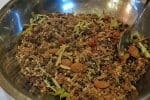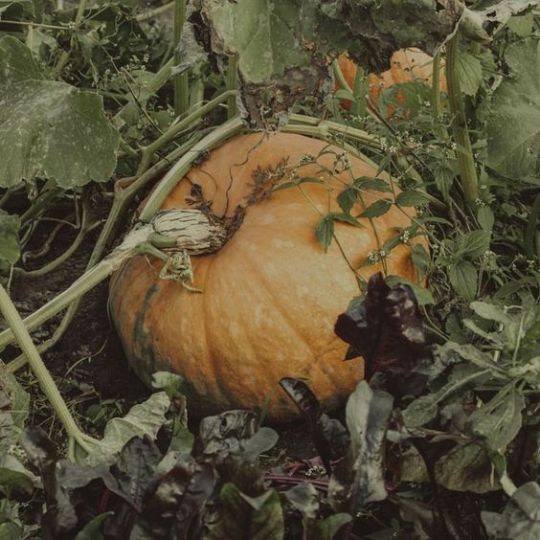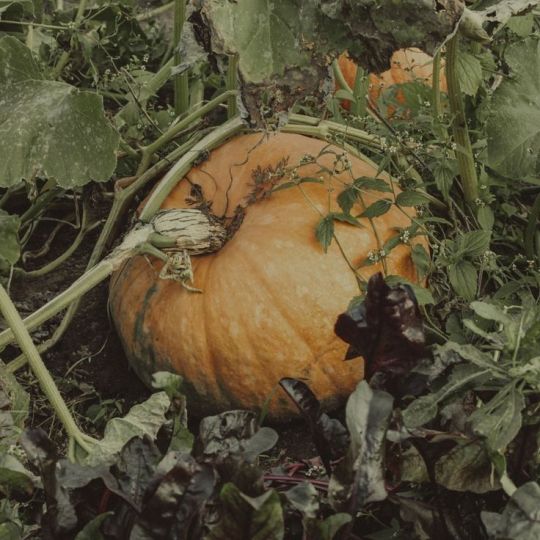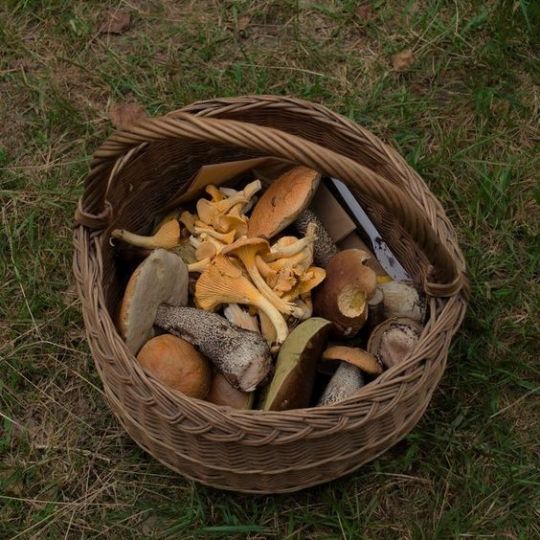#the oldest recipe for parsnip soup
Text






the oldest recipe for parsnip soup - eyra - Harry Potter [Archive of Our Own]
Chapters: 3/9
Fandom: Harry Potter
Rating: Mature
Relationships: Sirius Black/Remus Lupin
Additional Tags: Marauders Era, Non-Magical, Christmas, Winter, Cooking, Food, Fluff, Angst and Hurt/Comfort, Autistic Sirius Black (+ please check ao3 tags before reading)
There's something blazingly incongruous about Remus in the wintertime. He's golden: sunshine and honeybees, caramel curls and freckles like dappled sunlight. Even his clothes seem borrowed, and temporary, as if he might've just thrown on an extra layer for a moment in the knowledge that his own innate aestival nature would be quite enough to stave off the worst of the chill. Something at home in long balmy nights, and mornings when the gardens teem with life and song. Wonderfully out of place in the winter: a happy visitor to the season, an ember in the frost.
Christmastime in the Cotswolds: cold hands, crackling fires, and Remus's indefatigable quest for parsnips.
As is tradition, a festive treat for December. If you liked A Brief History of Dragons, this one's for you, and for anyone who has been following me on tumblr for a little while you'll understand why writing this was so important and cathartic and special for me, in lots of ways. A full circle moment.
I hope you love this as much as I do, and I hope you have a wonderful winter. x
#please check the ao3 tags before reading#parsnips#my writing#sirius black#remus lupin#james potter#marauders#fanfiction#wolfstar#christmas fic#the oldest recipe for parsnip soup
133 notes
·
View notes
Text

Im way to obsessed with this fic so i had to make a cover for it. This is from “the oldest recipe for parsnip soup” by @eyra which if you havent read then i think your just depriving yourself of joy at this point, are you ok? The amount of times this fic made me want to cook and gave me comfort even with some of the darker moments.
As usual , all the links to my yt and patreon are on my caard if you want to support me and my delusional work more ->
#art#artwork#artists on tumblr#digital art#digital illustration#illustration#digital painting#artist#marauders fanart#art study#marauders fluff#marauders era#wolfstar fanart#wolfstar#wolfstar headcanon#remus lupin fanart#remus fluff#remus fanart#remus lupin#sirius black fluff#sirius fanart#sirius black fanart#sirius black#eyra#soup#Spotify
245 notes
·
View notes
Text
wolfstar wips
So I'm using the @hprecfest day 12 prompt "a WIP you're following" to post a short rec list of WIPs that has been sitting in my drafts for so long now I even had to remove a fic that had been finished in the meanwhile!
Something rotten in Grimmauld Place by @plecotusauritus (8,802 words, Hamlet AU) This is a wolfstar Hamlet AU, need I say more?? I've never much cared or thought about Hamlet since I read it in school but this fic (almost) makes me want to reread Hamlet and I can't wait to see where the story goes next, I love the atmosphere this fic captures, the lovely writing style and just seeing all these characters we know so well fit into the plot of Hamlet is so, so cool!!
the oldest recipe for parsnip soup by @eyra (10.639 words, modern AU, christmas fic) Getting another fic by eyra for the holidays has been such a wonderful treat! I love the whole setting and the characters of this fic so much already, especially Sirius!! And the writing and all the descriptions are so, so beautiful, as always, highly recommend checking it out!!
Welcome to Aphrodite by @de-sire-blog & @rhabarberjunge (18.957 words, magical AU, secret identities) this is one of those fics I've read a while ago, but I keep thinking about it because I loved it so much. I don't want to give away too much of the plot, but the premise is Sirius finding a hidden, adults-only club that makes people's secret desires come true, and of course Sirius's secret desire is Remus... It's hot, it's fun, and it's incredibly angsty, I love it.
Stitched into My Skin by @squintclover (19.297 words, canon divergent AU, memory loss) I love the heartache and all the bittersweetness that comes with memory loss fics so much already, and I am so obsessed with the way it's been done in this fic. The premise of the fic is Peter casting a memory loss charm on Sirius on October 31st 1981, which leads to Remus raising Harry and randomly coming across Sirius years later, only Sirius doesn't remember him. I'm so intrigued by the first few chapters already and can't wait to see where the story goes next!
Marauder FM by @hollyivydruzy (26.402 words, modern AU, radio AU, enemies to friends to lovers) I know I've recced this fic before but I will never shut up about it because I love it, and especially this fic's Remus so, so much! It's an iconic, funny radio AU set in London, and I wish the radio shows from this fic were real because I would listen to Sirius's radio show every morning if I could. I just love the vibe of all of them working at the radio station together and the slow burn enemies to friends (to lovers) is so delicious!
The Patchwork of Us by @tracingpatternswrites (27.502 words, modern AU, enemies to lovers, co-parenting Teddy) This is such a lovely fic about Sirius and Remus navigating the difficult situation of co-parenting Teddy after Tonks dies, I love the domesticity and the enemies to lovers vibe of this fic so much!
The Picture of Sirius Black by @lynxindisguise (30.049 words, Dorian Gray AU) okay anyone who has ever seen my blog knows how much I love lynx's writing, which is why I am also obsessed with this fic, even though it's a genre I'm usually not that familiar with. It's a Dorian Gray AU, it's gothic horror but especially the first few chapters are also giving victorian romcom with murder sideplot vibes (and I mean this as the biggest compliment), this fic will make you laugh and cry and want to murder some of these characters yourself maybe.
Only Fools Are Satisfied by grumposaur (@pancakehouse) (38.353 words, modern AU, tennis AU). I really love the exploration of Sirius's family dynamics in the context of him being a professional athlete in this fic, and Remus with his tanlines and freckles is everything!!
Neon Moon by @krethes (47.698 words, modern AU, cowboy stripper Remus AU, Las Vegas) I didn't know how much I needed Remus to be a stripper and a cowboy before I read this fic, but now I do and I love him!! The whole premise of them meeting at a strip club while Sirius is out on James's bachelor party is so iconic, and the vibes of the fic are just overall excellent, highly recommend checking it out!
on another ocean by @colgatebluemintygel (118.148 words, modern AU, backpacking/interrail, friends with benefits) Where do I even start? This is an incredible fic, one of my all time faves, I've reread some of the chapters several times now and am so obsessed with this fic's Remus in his socks and sandals, driving Sirius crazy with lust. Also I will not spoil it for anyone who hasn't read it, but the scene in the budapest chapter in the club bathroom features one of my favorite Sirius moments of all time, across all universes haha.
marginalia by @spindrifters (266.547 words, magical AU, canon divergent AU - Grindelwald won, slavery AU) I'm having a hard time trying to put my love for this fic into words in just a short paragraph. This fic is so unique in its setting, and it's so beautifully written and asks & answers the question "what if Grindelwald had won?" in such an incredible, highly political and also very immersive way, if you haven't read it already I really recommend checking it out (as well as the already complete Tedromeda spinoff set in the same world, history books!!!).
Staying Strangers by 3amAndCounting (319,368 words, modern AU, texting fic, university AU). This is one of my comfort fics, I love a good texting AU, this is quite a popular fic anyways but if you haven't read it and like modern AUs & texting fics (though it isn't all just texting) go check it out!
#hprecfest2023#wolfstar wip#wolfstar#fic rec#wolfstar fic#wip#rec list#wip rec list#also i put these in order of their lenght because whenever i do a rec list that's not just chronological from doing daily fic recs#i have a small crisis over in which order i want to put them#also i just KNOW as soon as i post this i will remember another wip i've forgotten to mention so PLEASE feel free to reblog this and add#more current wolfstar wips (either ur own or someone elses!) if you want to!!! <3
174 notes
·
View notes
Text
alright so i finished reading the oldest recipe for parsnip soup and its got me thinking so much honestly.
first up, as always, the wonderful writer that is eyra has absolutely outdone themselves once again and wrangled that magic of theirs in that way that only they can do. If you haven't read it yet, please please do. you will fall so far in love i cannot possibly warn you sufficiently.
anyway its got me thinking a couple things:
we are so so bloody lucky in the fanfic community/fandom to have access to stories like this. they're beautiful, relatable and so bloody thought-provoking. they often, respectfully, shit all over so many of the published books i read that i have to put them down and do a little emotional support lap.
2. the second thing is that any time i read a representation of neurodiverse people, i pay such close attention to how the people around them treat that character. so like, their friends or their family or people in shops and strangers on the street. and as someone who has a little touch of the spicy brain, but more importantly, is friends with many, many wonderful people who sit in this colourful category, it strikes me how much it hits when these characters are treated in a way that is kind, and effortless. Like, it's actually not hard, y'know? I hear stories of how my friends are often treated by other friends of theirs and I just think, it's actually not a difficult thing to accommodate you. and not infantilize you. and yet...
I had a friend recently tell me how well i can read them for what their needs are in a variety of situations, and how grateful they are for that. and I just feel like... the bar is in hell. because it's not difficult. its literally not rocket science. its certainly not something i have to ponder over.
so when I read something like this fic in particular, where James is so cognizant of Sirius and the sort of actions and conversations that will help him thrive, it just fucking hits different. it feels effortless and unimportant. because... well, it should be.
same as how remus' friends treat him in kill your darlings by messermoon.
it's so simple, but it's so incredibly easy to be aware, and to be inclusive.
38 notes
·
View notes
Text
Figs fic-recs
I’ve read some incredible fics these last few days some of which have been sitting on my tbr in wait for lazy days to read them. So in no particular order
The oldest recipe for parsnip soup - eyra
So sweet and healing and lovely. Captures the Christmas spirit perfectly. I would take a bullet for all characters in this fic, no question. And the food!!
A grave mistake - soloorganaas
Angst and love and humour and healing in a perfect blend for this fix-it-fic, with one of the best lines delivered by Remus: “There’s a lot of things I do behind Sirius. But hiding is not one of them.”
Winterlude - otrtbs
Regulus as an art restorer? James as a trust fund baby with a ruined painting? Need I say more? Fun and flirty and all that hesitance and raw chemistry one can only find in a jegulus fic.
Across the blades of growing grass - thebloatedfrog
So so so sweet falling in love on a remote island and fumbling around in a tent, riding quads as foreplay. Love it.
#I feel so lucky having found and read all of these#what a treat#wolfstar#jegulus#fic rec#archive of our own#fanfic
21 notes
·
View notes
Text
How to Grow Caraway
Table of Contents
History of Caraway
How to Plant Caraway
Harvesting Caraway Seeds
Health Benefits of Caraway
Caraway Essential Oil Benefits
Cooking With Caraway
Caraway (Carum carvi) is an aromatic herbaceous plant, but is better known for their seeds. The origins of the name come from the Arabic “al-karwiya” seeds. Others believe the origin of the name is Latin from the word carvi, originating from Caria where the caraway plant may have first been used.1
Growing caraway requires some patience as the plant is biennial.2 This means the plant has a two-year biological cycle. In the first year, it produces a root structure, stems and leaves. During the second growing season, the plant completes the formation of flowers, fruit or seeds. Following the second season, many will reseed and then the plant usually dies. Most biennials are vegetables.
Caraway is usually grown for its intensely scented seeds or as a parsnip-like root vegetable.3 It is hardy, growing to about 8 inches in the first year with finely divided leaves and a long taproot. By the second year, the stalks grow up to 36 inches and develop white or pink flowers appearing between May and August.
Caraway seeds are often added to breads, cakes, soups and cabbage dishes to add a pungent flavor. By some accounts, it’s the oldest known condiment and was once a key ingredient in love potions.
History of Caraway Dates to the Stone Age
Archaeologists have dated the plant to the Stone Age and it has also been found in Egyptian tombs. The first century Greek physician Dioscorides used it to make a tonic to restore the color in the cheeks of those with pale complexions. Julius Caesar’s favorite bread was made with caraway seeds and it was a favored medicine in ancient civilizations of Egypt, Persia and Greece.4
Caraway was first introduced in England in the 14th century in a cookbook compiled for King Richard II. Later it was eaten at the end of a meal to cleanse the palate. William Shakespeare helped popularize this practice in a scene from Henry IV when, in an invitation to Falstaff, he was invited to5 “partake of a pippin … with a dish of caraway.”
German, Austrian, Dutch and Eastern European cooks tend to use the herb to balance fatty meats like duck and goose. Caraway also has a history of use outside the kitchen as Egyptians reportedly buried their dead with the plant to ward off evil spirits, or to protect against theft. The ancient Greeks used it in cosmetic solutions and as a light sedative.6
In German folklore, caraway seeds were placed beneath children’s beds to ward off witches. It was also added to chicken feed in the hopes it would keep the animals from wandering off. Today, it is still sometimes given to homing pigeons.7
How to Plant Caraway
The caraway plant is a cool-season biennial,8 doing best in sun or partial shade in zones 4 through 10.9 In cooler zones, the plant appreciates full sun, while in warmer zones it needs partial shade during the heat of the afternoon sun.
Since the caraway plant has a long tap root, it doesn’t do well in small containers. If a container garden is your choice, be sure the pot is at least 8 in deep — the deeper the better. Prepare your soil with organic matter and keep the pH between 6.0 and 7.5.10
Caraway plants should be sown either in the spring or autumn. In the springtime, plant the seeds after the last frost. For an earlier start, consider planting indoors in a tray. However, ensure you transplant the plants to the garden before the root appears, as it is easily damaged.11
Caraway can also be started from seed in the fall for early spring plants. If planting in the fall, give them winter protection so they produce flowers and seeds in the second year. Additionally, the plant can be started from cuttings of new growth taken in the summer or fall.
Sow the seeds one-fourth inch deep and then thin the seedlings to 12 to 18 inches apart. The plants appreciate moist soil without developing a water log in the roots. They do not like humidity, however, so don’t use overhead watering.12 Fortunately, the plant is not usually affected by insects. Foliage challenges may be prevented by allowing the leaves to dry between watering.13
Harvest Your Caraway Seeds and Store for the Future
The leaves of the plant can be harvested from spring onward once the plant is well-established and at least 6 inches or taller.14 Use them immediately in fresh salads or dry them on a flat tray and store in an airtight container for flavoring later. In this way, they can last for up to a year.
The seeds should be harvested once they appear on the plant and develop a deep brown color. To do this, cut the seed heads, including a fairly long stalk, using shears or a sharp knife to avoid damaging the plant. If you leave the seed head in the garden too long, the plant will reseed the garden in a good stiff wind.15
Tie a piece of muslin or paper bag around the seed head and hang the stems upside down to allow the plant to continue to ripen. When the seeds are ready, they’ll fall out of the seed head and into the bag or muslin.
Fresh seeds can be replanted immediately, or they can be placed on a fine-mesh to dry for several days and then stored in an airtight container to be used in the kitchen.16 Once you harvest your seeds, consider digging up the tap root and using it as you would any other root vegetable, cutting it and cooking soups or stews.17
Numerous Potential Health Benefits of Caraway
The plant is easy to grow, care for and harvest in your own garden, giving you easy access to an excellent source of potassium and calcium. Caraway also contains powerful antioxidant phytochemicals, the most prevalent of which are the carotenoids lutein and zeaxanthin, which help neutralize and remove free radicals and prevent degenerative diseases.
Caraway is also high in fiber and contains vitamins C, A, E and B complex. Adding the leaves, seeds and root and to your regular diet can be beneficial to your health in a number of ways. For instance caraway may help:18,19
Promote digestive health — A 100-gram serving of caraway seeds provides 38 grams of fiber,20 a dietary component that helps maintain proper digestive health promoting regularity and helps reduce your risk of stomach and intestinal diseases.
Fight microbes — Caraway essential oil has antibacterial properties, and has been found to help inhibit harmful organisms like salmonella.21
Manage inflammation — According to Organic Facts, taking caraway oil with raw honey or warm water may help loosen up mucus in the respiratory system as well as control the inflammation in the airways.22 Even smelling the powerful oil may help break up congestion from coughs and colds and provide relief for those with bronchitis.
Improve sleep quality — Magnesium, a mineral found in caraway seeds, may help enhance the duration, quality and tranquility of sleep, leaving you feeling better for the next day.
Don’t Overlook the Benefits From Caraway Essential Oil
The essential oil from the caraway plant has been used in manufacturing processes, such as for flavor in certain medications or fragrances for soaps and toothpaste. Caraway oil is also used in aromatherapy and appreciated for its warming and stress-relieving properties.
Caraway oil promotes skin and hair health as it is an effective tissue regenerator. Some find it helps fight oily skin, clear acne and heal bruises and boils. The oil has antiseptic, antihistamine, antispasmodic, digestive and disinfectant properties making it beneficial for23 treating or alleviating indigestion, heart ailments, urinary issues and internal infections.
The oil is made from distilling the seeds of the plant and is usually used topically or inhaled. Try diffusing it in a burner or vaporizer, blending it with massage oil or adding it to a cream or lotion.
While generally safe for most, I do not recommend it for pregnant women as it can induce menstruation. I advise you do a sensitivity test on a small area before applying generally or using it in a vaporizer or inhaler. Apply a drop of diluted oil to the inner aspect of your elbow and observe for a reaction over 24 hours.
Skin irritations, such as rashes and itching may occur when you use the oil high concentrations even if you do not have an allergy to the oil, so be sure to dilute it with a safe carrier oil before applying it on your skin.
Cooking With Caraway
Caraway has an aromatic, sweet taste with a licorice flavor that adds richness to your dishes. Caraway seeds make for an interesting twist when making sauerkraut and the roots may be added to a pan of roasted autumn vegetables. The leaves may be added to salad as a flavor herb. This crispy chicken recipe is adapted from All Recipes:24
Crispy Roasted Chicken
Ingredients
1 teaspoon kosher salt
½ teaspoon caraway seeds
½ teaspoon dried sage
¼ teaspoon fennel seeds
¼ teaspoon coriander seeds
¼ teaspoon dried rosemary
2 tablespoons paprika
2 teaspoons garlic powder
2 teaspoons all-purpose flour
1 teaspoon onion powder
5 tablespoons olive or coconut oil
1 whole chicken, cut in half lengthwise
Procedure
Heat your oven to 425 degrees Fahrenheit (F).
Combine the kosher salt, caraway seeds, sage, fennel, coriander and rosemary in a spice grinder or mortar and grind to a coarse powder.
Add the mixture to a bowl and stir in paprika, garlic powder, flour and onion powder, then add the oil to make a smooth paste.
Pat chicken halves dry with paper towels, taking care to wear gloves and dispose of the towels safely to avoid potential cross contamination.
Brush spice paste onto the halves, coating both sides and taking care to season under wings and legs.
Place in a baking dish with skin sides up, leaving space around the chicken so halves aren’t touching.
Roast until a meat thermometer inserted in a thigh reads 165 F, or about one hour.
Remove from the oven and let rest for 10 minutes before slicing.
from Articles http://articles.mercola.com/sites/articles/archive/2019/02/08/xdjm18-gardening-18mcsa-how-to-grow-caraway.aspx
source https://niapurenaturecom.tumblr.com/post/182650366231
0 notes
Text
How to Grow Caraway
Table of Contents
History of Caraway
How to Plant Caraway
Harvesting Caraway Seeds
Health Benefits of Caraway
Caraway Essential Oil Benefits
Cooking With Caraway
Caraway (Carum carvi) is an aromatic herbaceous plant, but is better known for their seeds. The origins of the name come from the Arabic "al-karwiya" seeds. Others believe the origin of the name is Latin from the word carvi, originating from Caria where the caraway plant may have first been used.1
Growing caraway requires some patience as the plant is biennial.2 This means the plant has a two-year biological cycle. In the first year, it produces a root structure, stems and leaves. During the second growing season, the plant completes the formation of flowers, fruit or seeds. Following the second season, many will reseed and then the plant usually dies. Most biennials are vegetables.
Caraway is usually grown for its intensely scented seeds or as a parsnip-like root vegetable.3 It is hardy, growing to about 8 inches in the first year with finely divided leaves and a long taproot. By the second year, the stalks grow up to 36 inches and develop white or pink flowers appearing between May and August.
Caraway seeds are often added to breads, cakes, soups and cabbage dishes to add a pungent flavor. By some accounts, it's the oldest known condiment and was once a key ingredient in love potions.
History of Caraway Dates to the Stone Age
Archaeologists have dated the plant to the Stone Age and it has also been found in Egyptian tombs. The first century Greek physician Dioscorides used it to make a tonic to restore the color in the cheeks of those with pale complexions. Julius Caesar's favorite bread was made with caraway seeds and it was a favored medicine in ancient civilizations of Egypt, Persia and Greece.4
Caraway was first introduced in England in the 14th century in a cookbook compiled for King Richard II. Later it was eaten at the end of a meal to cleanse the palate. William Shakespeare helped popularize this practice in a scene from Henry IV when, in an invitation to Falstaff, he was invited to5 "partake of a pippin … with a dish of caraway."
German, Austrian, Dutch and Eastern European cooks tend to use the herb to balance fatty meats like duck and goose. Caraway also has a history of use outside the kitchen as Egyptians reportedly buried their dead with the plant to ward off evil spirits, or to protect against theft. The ancient Greeks used it in cosmetic solutions and as a light sedative.6
In German folklore, caraway seeds were placed beneath children's beds to ward off witches. It was also added to chicken feed in the hopes it would keep the animals from wandering off. Today, it is still sometimes given to homing pigeons.7
How to Plant Caraway
The caraway plant is a cool-season biennial,8 doing best in sun or partial shade in zones 4 through 10.9 In cooler zones, the plant appreciates full sun, while in warmer zones it needs partial shade during the heat of the afternoon sun.
Since the caraway plant has a long tap root, it doesn't do well in small containers. If a container garden is your choice, be sure the pot is at least 8 in deep — the deeper the better. Prepare your soil with organic matter and keep the pH between 6.0 and 7.5.10
Caraway plants should be sown either in the spring or autumn. In the springtime, plant the seeds after the last frost. For an earlier start, consider planting indoors in a tray. However, ensure you transplant the plants to the garden before the root appears, as it is easily damaged.11
Caraway can also be started from seed in the fall for early spring plants. If planting in the fall, give them winter protection so they produce flowers and seeds in the second year. Additionally, the plant can be started from cuttings of new growth taken in the summer or fall.
Sow the seeds one-fourth inch deep and then thin the seedlings to 12 to 18 inches apart. The plants appreciate moist soil without developing a water log in the roots. They do not like humidity, however, so don't use overhead watering.12 Fortunately, the plant is not usually affected by insects. Foliage challenges may be prevented by allowing the leaves to dry between watering.13
Harvest Your Caraway Seeds and Store for the Future
The leaves of the plant can be harvested from spring onward once the plant is well-established and at least 6 inches or taller.14 Use them immediately in fresh salads or dry them on a flat tray and store in an airtight container for flavoring later. In this way, they can last for up to a year.
The seeds should be harvested once they appear on the plant and develop a deep brown color. To do this, cut the seed heads, including a fairly long stalk, using shears or a sharp knife to avoid damaging the plant. If you leave the seed head in the garden too long, the plant will reseed the garden in a good stiff wind.15
Tie a piece of muslin or paper bag around the seed head and hang the stems upside down to allow the plant to continue to ripen. When the seeds are ready, they'll fall out of the seed head and into the bag or muslin.
Fresh seeds can be replanted immediately, or they can be placed on a fine-mesh to dry for several days and then stored in an airtight container to be used in the kitchen.16 Once you harvest your seeds, consider digging up the tap root and using it as you would any other root vegetable, cutting it and cooking soups or stews.17
Numerous Potential Health Benefits of Caraway
The plant is easy to grow, care for and harvest in your own garden, giving you easy access to an excellent source of potassium and calcium. Caraway also contains powerful antioxidant phytochemicals, the most prevalent of which are the carotenoids lutein and zeaxanthin, which help neutralize and remove free radicals and prevent degenerative diseases.
Caraway is also high in fiber and contains vitamins C, A, E and B complex. Adding the leaves, seeds and root and to your regular diet can be beneficial to your health in a number of ways. For instance caraway may help:18,19
Promote digestive health — A 100-gram serving of caraway seeds provides 38 grams of fiber,20 a dietary component that helps maintain proper digestive health promoting regularity and helps reduce your risk of stomach and intestinal diseases.
Fight microbes — Caraway essential oil has antibacterial properties, and has been found to help inhibit harmful organisms like salmonella.21
Manage inflammation — According to Organic Facts, taking caraway oil with raw honey or warm water may help loosen up mucus in the respiratory system as well as control the inflammation in the airways.22 Even smelling the powerful oil may help break up congestion from coughs and colds and provide relief for those with bronchitis.
Improve sleep quality — Magnesium, a mineral found in caraway seeds, may help enhance the duration, quality and tranquility of sleep, leaving you feeling better for the next day.
Don't Overlook the Benefits From Caraway Essential Oil
The essential oil from the caraway plant has been used in manufacturing processes, such as for flavor in certain medications or fragrances for soaps and toothpaste. Caraway oil is also used in aromatherapy and appreciated for its warming and stress-relieving properties.
Caraway oil promotes skin and hair health as it is an effective tissue regenerator. Some find it helps fight oily skin, clear acne and heal bruises and boils. The oil has antiseptic, antihistamine, antispasmodic, digestive and disinfectant properties making it beneficial for23 treating or alleviating indigestion, heart ailments, urinary issues and internal infections.
The oil is made from distilling the seeds of the plant and is usually used topically or inhaled. Try diffusing it in a burner or vaporizer, blending it with massage oil or adding it to a cream or lotion.
While generally safe for most, I do not recommend it for pregnant women as it can induce menstruation. I advise you do a sensitivity test on a small area before applying generally or using it in a vaporizer or inhaler. Apply a drop of diluted oil to the inner aspect of your elbow and observe for a reaction over 24 hours.
Skin irritations, such as rashes and itching may occur when you use the oil high concentrations even if you do not have an allergy to the oil, so be sure to dilute it with a safe carrier oil before applying it on your skin.
Cooking With Caraway
Caraway has an aromatic, sweet taste with a licorice flavor that adds richness to your dishes. Caraway seeds make for an interesting twist when making sauerkraut and the roots may be added to a pan of roasted autumn vegetables. The leaves may be added to salad as a flavor herb. This crispy chicken recipe is adapted from All Recipes:24
Crispy Roasted Chicken
Ingredients
1 teaspoon kosher salt
1/2 teaspoon caraway seeds
1/2 teaspoon dried sage
1/4 teaspoon fennel seeds
1/4 teaspoon coriander seeds
1/4 teaspoon dried rosemary
2 tablespoons paprika
2 teaspoons garlic powder
2 teaspoons all-purpose flour
1 teaspoon onion powder
5 tablespoons olive or coconut oil
1 whole chicken, cut in half lengthwise
Procedure
Heat your oven to 425 degrees Fahrenheit (F).
Combine the kosher salt, caraway seeds, sage, fennel, coriander and rosemary in a spice grinder or mortar and grind to a coarse powder.
Add the mixture to a bowl and stir in paprika, garlic powder, flour and onion powder, then add the oil to make a smooth paste.
Pat chicken halves dry with paper towels, taking care to wear gloves and dispose of the towels safely to avoid potential cross contamination.
Brush spice paste onto the halves, coating both sides and taking care to season under wings and legs.
Place in a baking dish with skin sides up, leaving space around the chicken so halves aren't touching.
Roast until a meat thermometer inserted in a thigh reads 165 F, or about one hour.
Remove from the oven and let rest for 10 minutes before slicing.
from
http://articles.mercola.com/sites/articles/archive/2019/02/08/xdjm18-gardening-18mcsa-how-to-grow-caraway.aspx
source http://niapurenaturecom.weebly.com/blog/how-to-grow-caraway
0 notes
Text
How to Grow Caraway
Table of Contents
History of Caraway
How to Plant Caraway
Harvesting Caraway Seeds
Health Benefits of Caraway
Caraway Essential Oil Benefits
Cooking With Caraway
Caraway (Carum carvi) is an aromatic herbaceous plant, but is better known for their seeds. The origins of the name come from the Arabic "al-karwiya" seeds. Others believe the origin of the name is Latin from the word carvi, originating from Caria where the caraway plant may have first been used.1
Growing caraway requires some patience as the plant is biennial.2 This means the plant has a two-year biological cycle. In the first year, it produces a root structure, stems and leaves. During the second growing season, the plant completes the formation of flowers, fruit or seeds. Following the second season, many will reseed and then the plant usually dies. Most biennials are vegetables.
Caraway is usually grown for its intensely scented seeds or as a parsnip-like root vegetable.3 It is hardy, growing to about 8 inches in the first year with finely divided leaves and a long taproot. By the second year, the stalks grow up to 36 inches and develop white or pink flowers appearing between May and August.
Caraway seeds are often added to breads, cakes, soups and cabbage dishes to add a pungent flavor. By some accounts, it's the oldest known condiment and was once a key ingredient in love potions.
History of Caraway Dates to the Stone Age
Archaeologists have dated the plant to the Stone Age and it has also been found in Egyptian tombs. The first century Greek physician Dioscorides used it to make a tonic to restore the color in the cheeks of those with pale complexions. Julius Caesar's favorite bread was made with caraway seeds and it was a favored medicine in ancient civilizations of Egypt, Persia and Greece.4
Caraway was first introduced in England in the 14th century in a cookbook compiled for King Richard II. Later it was eaten at the end of a meal to cleanse the palate. William Shakespeare helped popularize this practice in a scene from Henry IV when, in an invitation to Falstaff, he was invited to5 "partake of a pippin … with a dish of caraway."
German, Austrian, Dutch and Eastern European cooks tend to use the herb to balance fatty meats like duck and goose. Caraway also has a history of use outside the kitchen as Egyptians reportedly buried their dead with the plant to ward off evil spirits, or to protect against theft. The ancient Greeks used it in cosmetic solutions and as a light sedative.6
In German folklore, caraway seeds were placed beneath children's beds to ward off witches. It was also added to chicken feed in the hopes it would keep the animals from wandering off. Today, it is still sometimes given to homing pigeons.7
How to Plant Caraway
The caraway plant is a cool-season biennial,8 doing best in sun or partial shade in zones 4 through 10.9 In cooler zones, the plant appreciates full sun, while in warmer zones it needs partial shade during the heat of the afternoon sun.
Since the caraway plant has a long tap root, it doesn't do well in small containers. If a container garden is your choice, be sure the pot is at least 8 in deep — the deeper the better. Prepare your soil with organic matter and keep the pH between 6.0 and 7.5.10
Caraway plants should be sown either in the spring or autumn. In the springtime, plant the seeds after the last frost. For an earlier start, consider planting indoors in a tray. However, ensure you transplant the plants to the garden before the root appears, as it is easily damaged.11
Caraway can also be started from seed in the fall for early spring plants. If planting in the fall, give them winter protection so they produce flowers and seeds in the second year. Additionally, the plant can be started from cuttings of new growth taken in the summer or fall.
Sow the seeds one-fourth inch deep and then thin the seedlings to 12 to 18 inches apart. The plants appreciate moist soil without developing a water log in the roots. They do not like humidity, however, so don't use overhead watering.12 Fortunately, the plant is not usually affected by insects. Foliage challenges may be prevented by allowing the leaves to dry between watering.13
Harvest Your Caraway Seeds and Store for the Future
The leaves of the plant can be harvested from spring onward once the plant is well-established and at least 6 inches or taller.14 Use them immediately in fresh salads or dry them on a flat tray and store in an airtight container for flavoring later. In this way, they can last for up to a year.
The seeds should be harvested once they appear on the plant and develop a deep brown color. To do this, cut the seed heads, including a fairly long stalk, using shears or a sharp knife to avoid damaging the plant. If you leave the seed head in the garden too long, the plant will reseed the garden in a good stiff wind.15
Tie a piece of muslin or paper bag around the seed head and hang the stems upside down to allow the plant to continue to ripen. When the seeds are ready, they'll fall out of the seed head and into the bag or muslin.
Fresh seeds can be replanted immediately, or they can be placed on a fine-mesh to dry for several days and then stored in an airtight container to be used in the kitchen.16 Once you harvest your seeds, consider digging up the tap root and using it as you would any other root vegetable, cutting it and cooking soups or stews.17
Numerous Potential Health Benefits of Caraway
The plant is easy to grow, care for and harvest in your own garden, giving you easy access to an excellent source of potassium and calcium. Caraway also contains powerful antioxidant phytochemicals, the most prevalent of which are the carotenoids lutein and zeaxanthin, which help neutralize and remove free radicals and prevent degenerative diseases.
Caraway is also high in fiber and contains vitamins C, A, E and B complex. Adding the leaves, seeds and root and to your regular diet can be beneficial to your health in a number of ways. For instance caraway may help:18,19
Promote digestive health — A 100-gram serving of caraway seeds provides 38 grams of fiber,20 a dietary component that helps maintain proper digestive health promoting regularity and helps reduce your risk of stomach and intestinal diseases.
Fight microbes — Caraway essential oil has antibacterial properties, and has been found to help inhibit harmful organisms like salmonella.21
Manage inflammation — According to Organic Facts, taking caraway oil with raw honey or warm water may help loosen up mucus in the respiratory system as well as control the inflammation in the airways.22 Even smelling the powerful oil may help break up congestion from coughs and colds and provide relief for those with bronchitis.
Improve sleep quality — Magnesium, a mineral found in caraway seeds, may help enhance the duration, quality and tranquility of sleep, leaving you feeling better for the next day.
Don't Overlook the Benefits From Caraway Essential Oil
The essential oil from the caraway plant has been used in manufacturing processes, such as for flavor in certain medications or fragrances for soaps and toothpaste. Caraway oil is also used in aromatherapy and appreciated for its warming and stress-relieving properties.
Caraway oil promotes skin and hair health as it is an effective tissue regenerator. Some find it helps fight oily skin, clear acne and heal bruises and boils. The oil has antiseptic, antihistamine, antispasmodic, digestive and disinfectant properties making it beneficial for23 treating or alleviating indigestion, heart ailments, urinary issues and internal infections.
The oil is made from distilling the seeds of the plant and is usually used topically or inhaled. Try diffusing it in a burner or vaporizer, blending it with massage oil or adding it to a cream or lotion.
While generally safe for most, I do not recommend it for pregnant women as it can induce menstruation. I advise you do a sensitivity test on a small area before applying generally or using it in a vaporizer or inhaler. Apply a drop of diluted oil to the inner aspect of your elbow and observe for a reaction over 24 hours.
Skin irritations, such as rashes and itching may occur when you use the oil high concentrations even if you do not have an allergy to the oil, so be sure to dilute it with a safe carrier oil before applying it on your skin.
Cooking With Caraway
Caraway has an aromatic, sweet taste with a licorice flavor that adds richness to your dishes. Caraway seeds make for an interesting twist when making sauerkraut and the roots may be added to a pan of roasted autumn vegetables. The leaves may be added to salad as a flavor herb. This crispy chicken recipe is adapted from All Recipes:24
Crispy Roasted Chicken
Ingredients
1 teaspoon kosher salt
1/2 teaspoon caraway seeds
1/2 teaspoon dried sage
1/4 teaspoon fennel seeds
1/4 teaspoon coriander seeds
1/4 teaspoon dried rosemary
2 tablespoons paprika
2 teaspoons garlic powder
2 teaspoons all-purpose flour
1 teaspoon onion powder
5 tablespoons olive or coconut oil
1 whole chicken, cut in half lengthwise
Procedure
Heat your oven to 425 degrees Fahrenheit (F).
Combine the kosher salt, caraway seeds, sage, fennel, coriander and rosemary in a spice grinder or mortar and grind to a coarse powder.
Add the mixture to a bowl and stir in paprika, garlic powder, flour and onion powder, then add the oil to make a smooth paste.
Pat chicken halves dry with paper towels, taking care to wear gloves and dispose of the towels safely to avoid potential cross contamination.
Brush spice paste onto the halves, coating both sides and taking care to season under wings and legs.
Place in a baking dish with skin sides up, leaving space around the chicken so halves aren't touching.
Roast until a meat thermometer inserted in a thigh reads 165 F, or about one hour.
Remove from the oven and let rest for 10 minutes before slicing.
from HealthyLife via Jake Glover on Inoreader http://articles.mercola.com/sites/articles/archive/2019/02/08/xdjm18-gardening-18mcsa-how-to-grow-caraway.aspx
0 notes
Text
As I stir the Christmas pudding mix, I make a wish, as do each of us in turn. We are gathered in the stunning Jacobean Hall of a former medieval coaching inn now a luxury hotel, The Spread Eagle in Midhurst, West Sussex. It’s the Sunday before Advent Sunday and throughout England, Christmas puddings are being made, traditionally with all the family taking it in turn to stir the pudding and make a wish. The day is commonly called Stir-up Sunday, after the opening words of the main prayer said in Anglican Churches on this day, which says:
“Stir up, we beseech thee, O Lord, the wills of thy faithful people…”
Christmas in England would not be Christmas without a traditional Christmas pudding. You’ll find the recipe at the end of this post, but first I’d like to tell you more about the history of this delicious sweet treat.
Pin it for later!
A brief history of the Christmas pudding
The origins of the Christmas pudding date from medieval times. The late autumn was traditionally the time when weak animals were slaughtered. Continuing to feed them was an unnecessary expense as they were unlikely to survive the harsh winter. The glut of meat that this produced needed preserving, so the meat was diced and mixed with sweet, dried autumn fruits and spices and encased in pastry. This is thought to be the origin of both the Christmas pudding and another traditional Christmas treat in England, mince pies.
It was originally called frumenty or plum pottage, was cooked in beer rather than water (as the beer was safer to drink) and had a soup-like consistency.
In around the year 1600, people started adding breadcrumbs, dried fruit and spirits and became established as a Christmas tradition some 50 years later.
Did you know? In 1664 Oliver Cromwell banned Christmas puddings because they were unfitting for God-fearing people. They returned as a Christmas tradition some 50 years later, thanks to King George I.
Over the years, the ingredients developed further but it was not until 1845 that Eliza Acton, in the East Sussex village of Battle, wrote down the first Christmas pudding recipe as we know it today.
Stir-up Sunday at The Spread Eagle
Meanwhile at The Spread Eagle, a Christmas tradition of their own developed, which dates back well over one hundred years. Each Christmas Eve every guest at the hotel is given a homemade Christmas pudding. They can either take it home or have it tied to the ceiling in the hotel’s restaurant. The puddings stay there until the guests return the following Christmas, during which their pudding is cooked for them. Unclaimed Christmas puddings remain tied up to the ceiling year-round.
Having been invited to join Group Executive Head Chef and Roux Scholar Martin Hadden , at The Spread Eagle in Middleton, West Sussex, for their annual Stir-up Sunday, I was more than happy to oblige! The Spread Eagle is one of three privately owned luxury hotels, Historic Sussex Hotels. While I had recently spent a wonderful day at the spa at Bailiffscourt Hotel, I had never visited The Spread Eagle, an exceptional hotel and one of England’s oldest coaching inns.
We had a fabulous afternoon making our puddings and building up our appetites, before indulging in a very decadent afternoon tea. It was wonderful to see how much everyone enjoyed it. One family included three generations all making their Christmas puddings together. I came home with my Christmas pudding, which is steaming away as I write this, but I’m going to have to wait until Christmas Day before I can taste it.
Below: afternoon tea and the Spread Eagle, Midhurst, Sussex, England
How to make the perfect Christmas pudding
Lunch on Christmas Day is the most important meal of the year in England and as every Christmas host knows, it’s important to all that everything is cooked to perfection. A turkey, parsnips and potatoes are roasted and traditionally served with sprouts, carrots, stuffing, cranberry jelly and pork sausages wrapped in bacon. For dessert it MUST be Christmas pudding served with brandy butter and cream.
And don’t forget the crackers, another Christmas essential. The crackers are pulled open at the start of the meal and traditionally contain a bad joke, paper hat and some sort of small (usually pointless) gift! They’re an expensive bit of nonsense but one year we didn’t have them, and it just didn’t feel like Christmas.
Christmas Pudding

A must-have dessert for lunch on Christmas Day in Britain.
Once you have made the pudding and allowed it to rest for 24 hours, it must be steamed within a week of making, after which it should be stored in a cool, dark place until it is reheated on Christmas Day.
28 servings make four 700 g puddings. Each one should be steamed for 3 hours 40 minutes (plus one and half to two hours before to reheat it on the Christmas Day).
CLICK UNDER ‘SERVINGS’ TO DECREASE THE NUMBER OF SERVINGS
Traditionally, a silver sixpence was also added to the pudding, bringing luck to the person that found it on Christmas Day.
500 g raisins
250 g sultanas
250 g dark brown sugar
250 g breadcrumbs
70 g flour
250 g suet
125 g ground almonds
125 g candied citrus peel
125 g glace cherries
125 g glace apricots
2 lemons (zest only)
1 orange (zest only)
2 tsp mixed spice
1 tsp cinnamon
4 eggs
125 g apple
2 tbsp black treacle
100 ml brandy
100 ml ginger wine
To prepare the Christmas pudding
In a large bowl mix the raisins, sultanas, currants and dark brown sugar.
Add the breadcrumbs, flour, suet and ground almonds. Mix thoroughly.
Add the peel, cherries and apricots. Mix thoroughly.
Add the zest, mixed spice and cinnamon. Keep mixing.
Grate the unpeeled apple into the bowl.

Add the eggs. Mix thoroughly. You’ll start to feel the mixture firming up, making it harder to stir.
Lastly, stir in the treacle, brandy and ginger wine, making sure that everything is thoroughly mixed in.

Cover the bowl and leave in a fridge for 24 hours to let the flavours infuse.
Transfer the mixture into pudding bowls and pat down with the back of a spoon. Make sure to leave a gap at the top of the bowl.
Cover with a disc of greaseproof paper and tightly wrap the bowl in cling film.

To steam the pudding
Leaving the greaseproof paper over the pudding, cover the top in foil but allow space for the pudding to rise. Tie the foil in place with string.
Boil a large pan of water. Use a small upturned saucer at the bottom of your pan to protect your pudding bowl from the intense heat (which may cause your basin to crack).
Wrap the pudding in muslin cloth so that the ends of the cloth can be used to pick up the pudding (or add a string handle).
Stand the pudding in the water, making sure the water comes half way up the bowl but no higher.
Steam for the required time, topping up the water as necessary. Resist lifting the lid of the steaming pan for the first 30 minutes as the drop in temperature could cause the pudding to collapse.
Leave to cool then store in a cool, dry place until Christmas Day.
To reheat the pudding for serving
Steam for a further 1 and a half to 2 hours.
Lay the table with brandy butter, cream, custard and/or vanilla ice cream.
Dim the lights.
Make a small indent in the top of the pudding.
Fill it with brandy, letting some run down the side of the pudding.
Light the brandy and carry the pudding to the table.
How to make the perfect Christmas pudding As I stir the Christmas pudding mix, I make a wish, as do each of us in turn.
0 notes
Text
parsnip soup recipe book 🥄
as promised, here's a list of (most of) the recipes from the oldest recipe for parsnip soup. some of the dishes in the story have slight variances from the recipes below - purely just based on what ingredients I felt like adding or tweaking as I was writing - but they're not far off. enjoy! x



chapter 1: cheese and pickle sandwich, uneaten
I must stress to the uninitiated that the pickle in question is of course Branston pickle. serve with mature cheddar and granary bread.
chapter 2: two black coffees, to go
the deli in the story is a real deli that actually exists and they serve Ozone coffee.
chapter 3: sausage & leek pasta with chilli
this is a Julius Roberts one - the video that started it all.
chapter 4: wild mushroom gnocchi
would also work just fine with pasta.
chapter 5: spiced apple tea
this was an amalgamation of a few different recipes, but this one and this one both look good. I imagine this would also be delightful with a splash of something like amaretto.
chapter 6: cheese & curried onion toastie
Julius Roberts again. I haven't tried this yet but god I want to.
chapter 7: turkey, all the trimmings
the Christmas table recipes were all just drawn from stuff I usually eat at Christmas, but you can't go wrong with Nigella for the turkey and these sprouts and these sprouts both look good to me.
chapter 8: buttered toast, uneaten
there are few greater pleasures in life than a bit of cheap white bread, toasted, with good butter.
chapter 9: parsnip soup
obviously the actual recipe is a closely-guarded secret passed down from Remus's great-great-great-grandmother, but the one I've linked above will come pretty close.
🧄🧈🥄🧅🍞
133 notes
·
View notes
Text



the oldest recipe for parsnip soup - eyra - Harry Potter [Archive of Our Own]
Chapters: 8/9
Fandom: Harry Potter
Rating: Mature
Relationships: Sirius Black/Remus Lupin
Additional Tags: Marauders Era, Non-Magical, Christmas, Winter, Cooking, Food, Fluff, Angst and Hurt/Comfort, Autistic Sirius Black (+ please check ao3 tags before reading)
Chapter 8 is now up!
I hope everyone had a delighftul Christmas! Enjoy another chapter of James being the absolute best friend anyone could ever wish for. One more chapter to go...
Please check the updated tags before reading. x
Playlist here.
#my writing#the oldest recipe for parsnip soup#marauders#wolfstar#sirius black#remus lupin#christmas fic
87 notes
·
View notes
Text






the oldest recipe for parsnip soup - eyra - Harry Potter [Archive of Our Own]
Chapters: 9/9 - COMPLETE
Fandom: Harry Potter
Rating: Mature
Relationships: Sirius Black/Remus Lupin
Additional Tags: Marauders Era, Non-Magical, Christmas, Winter, Cooking, Food, Fluff, Angst and Hurt/Comfort, Autistic Sirius Black (+ please check ao3 tags before reading)
There's something blazingly incongruous about Remus in the wintertime. He's golden: sunshine and honeybees, caramel curls and freckles like dappled sunlight. Even his clothes seem borrowed, and temporary, as if he might've just thrown on an extra layer for a moment in the knowledge that his own innate aestival nature would be quite enough to stave off the worst of the chill. Something at home in long balmy nights, and mornings when the gardens teem with life and song. Wonderfully out of place in the winter: a happy visitor to the season, an ember in the frost.
Christmastime in the Cotswolds: cold hands, crackling fires, and Remus's indefatigable quest for parsnips.
Finished! 🥄❄️🧅
Thank you so much to everyone who's been reading along with this story - I really hope you like this last chapter. And for those who've been waiting to start reading: welcome in! Bring a spoon, enjoy! x
#my writing#the oldest recipe for parsnip soup#sirius black#remus lupin#wolfstar#marauders#christmas fic#thank you!#to everyone who's been reading along and leaving comments and kudos: I love you#merry christmas x
127 notes
·
View notes
Text



the oldest recipe for parsnip soup - eyra - Harry Potter [Archive of Our Own]
Chapters: 7/9
Fandom: Harry Potter
Rating: Mature
Relationships: Sirius Black/Remus Lupin
Additional Tags: Marauders Era, Non-Magical, Christmas, Winter, Cooking, Food, Fluff, Angst and Hurt/Comfort, Autistic Sirius Black (+ please check ao3 tags before reading)
Chapter 6 and Chapter 7 are both now up! 🎄🦃
Two of my favourite chapters. Pour yourself a festive drink, pop on some carols, and enjoy. Merry Christmas everyone! x
Playlist here.


#please remember to take note of the tags and the fact that this fic is rated M#my writing#the oldest recipe for parsnip soup#wolfstar#christmas fic#remus lupin#sirius black#james potter#marauders
83 notes
·
View notes
Text


skimming back through a very old fic of mine and gasped irl when I saw this line
73 notes
·
View notes
Text






the oldest recipe for parsnip soup - eyra - Harry Potter [Archive of Our Own]
Chapters: 4/9 - Chapter 4 now up
Fandom: Harry Potter
Rating: Mature
Relationships: Sirius Black/Remus Lupin
Additional Tags: Marauders Era, Non-Magical, Christmas, Winter, Cooking, Food, Fluff, Angst and Hurt/Comfort, Autistic Sirius Black (+ please check ao3 tags before reading)
There's something blazingly incongruous about Remus in the wintertime. He's golden: sunshine and honeybees, caramel curls and freckles like dappled sunlight. Even his clothes seem borrowed, and temporary, as if he might've just thrown on an extra layer for a moment in the knowledge that his own innate aestival nature would be quite enough to stave off the worst of the chill. Something at home in long balmy nights, and mornings when the gardens teem with life and song. Wonderfully out of place in the winter: a happy visitor to the season, an ember in the frost.
Christmastime in the Cotswolds: cold hands, crackling fires, and Remus's indefatigable quest for parsnips.
Chapter 4 is now up! 🥄🧅
Thank you to everyone who has commented/left kudos/messaged/reblogged/etc. so far on this story - really does mean a lot. There are a couple of angsty chapters here, and Chapter 4 is one of them, so mind the tags. x
#my writing#the oldest recipe for parsnip soup#sirius black#remus lupin#james potter#wolfstar#marauders#christmas fic
74 notes
·
View notes
Note
Oooh what about you’re fancasts for Remus Sirius and James!
so I don’t have fancasts as such but I do have vibes that kind of inspired me for these three in this fic specifically.
Remus is very this. ignore the accent but like extremely that. he was basically the starting point for this whole story. don’t tell him.
I stumbled upon this guy after I’d already finished writing but he has huge James energy - the way he terrorises his poor mum is perfect.
and for Sirius in this story I was just inspired by this random photo on Pinterest:

(imagine Bunny as a puppy please)
and this beautiful piece of fanart that I sadly don’t know the artist of - please tell me who it’s by if you know!

55 notes
·
View notes